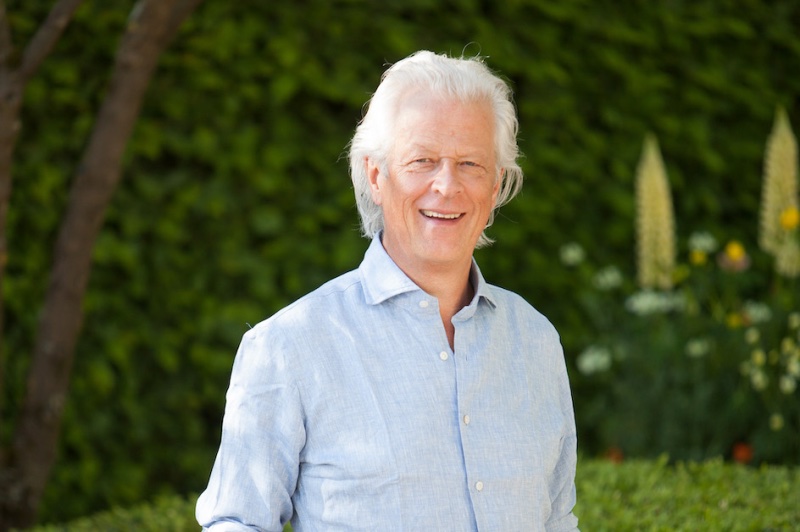By Mark Howarth
Recently, I had the enormous pleasure of interviewing the English landscape architect, Randle Siddeley, who amongst his peers has deservedly become known as ‘a modern-day Capability Brown’. I set out to discover his main influences, the design principles he works to, the way in which he deals with clients, and how he has adapted to the changing world of the landscape architect over the last 48 years.
Influences and inspiration
Randle began by telling me that he followed in the footsteps of his father who was ‘pretty famous in the world of design’. When he lived with his parents, he met many people who were involved in interior designing such as David Hicks and others, who were also influential.
He was interested in seeing how people go about creating their designs and one of the things that caught his eye was the Red Books of the famous late-18th, early-19th century landscape designer, Humphry Repton. In particular, he admired Repton’s technique of demonstrating to a client the ‘before’ and ‘after’ of a design, which made absolutely clear what their garden would eventually look like. In an interesting take on eighteenth-century methodology, Randle would photograph a garden and then would draw a new design using the photograph as a template.
Although Randle is described as ‘a modern-day Capability Brown’, he told me that neither Brown’s nor Repton’s garden designs particularly influenced him, and that he derives his main inspiration from what he sees, absorbing details wherever he goes.
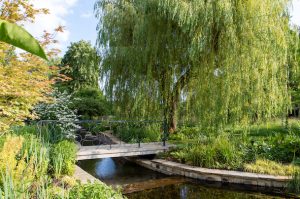 Photo credit: Georgina Viney Photography
Photo credit: Georgina Viney Photography
Design principles
For Randle, what is particularly important is to reflect first on what he sees and not think about how a garden might look there and then. It’s only later when pieces of the jigsaw begin to fall into place, he asks himself, ‘how can we make this work? What is the client’s brief, are we going to introduce water, or even, are the kids going to be playing football in the garden?’
In terms of working methods, his first step is to complete a concept design before talking through what the client is thinking of spending. The client’s constraints, aspirations and budget are all critical – it’s just like learning a new language.
Another crucial design principle for Randle is to think about the future: for example, he thought it important to consider how you plant trees to ensure their longevity. Randle reminded me that it’s easy to overplant trees. ‘The trouble with trees is that they grow and then they grow into each other. And you’re left with only the trees on the outside that are actually looking good with the ones in the middle cramped together inside…., as I always say, ‘plant a tree for posterity.’ Randle went on:
‘Sometimes you need to be a bit patient and manage things carefully. Interestingly, I designed The Old Rectory garden about 25 years ago, and it was one of the favourite gardens I did with a great big lake on it. The owner sold it and moved on, then it passed through someone else’s hands. Suddenly, I got a phone call from someone I knew who said he had just bought a really expensive garden.
I said, ‘gosh you’re so lucky – you have bought a beautiful garden, and the house was beautiful too!’ And to me, what was so exciting was going back and seeing it after all that time. I wanted to make sure that I hadn’t made any errors planting trees! From the moment I arrived, I hardly recognised it because the parkland had matured, and two smaller trees had matured substantially. And I just thought, ‘oh my God, it really has worked!’ I tried to make a few suggestions, but he said, ‘no Randle – I’m happy with it as it is!’
I went on to ask to what extent Randle considered a garden to be a multi-sensory experience. He replied that, for him, it was a visual experience more than anything else. It was important for someone to journey from one space to another and say to themselves, ‘OK, what’s around this corner’. In effect, you’re creating green visual barriers to differentiate each area that you go into. In design terms, he thought ‘the smaller the garden the harder it is, because you’re trying to do quite a lot in it’.
I was also interested in finding out Randle’s views on aftercare. He firmly believed that having designed and built a garden, it was equally important to be involved for as long as possible to ensure that everything was bedding in well. He preferred to have total control of a project including the choice of materials, which should always be of the highest quality.
Randle felt that design, construction and maintenance go together, and from his perspective, maintenance was absolutely crucial. He went on to say, ‘what do you think if you visit a property and the plants outside are all half-dead? It doesn’t give you the right impression: first impressions are crucial’. He warned against giving responsibility for maintenance to a separate contractor, because the link becomes broken and the garden doesn’t necessarily turn out as you wanted.
Finally, Randle made a very pertinent point about design. He said, ‘you should always judge a garden by what it looks like in winter. That’s when you know you have a good garden design, because it must have good proportions and there needs to be some greenery in the background. If the garden looks relatively handsome and well-structured in winter, then you’ve got a great, well-designed garden’.
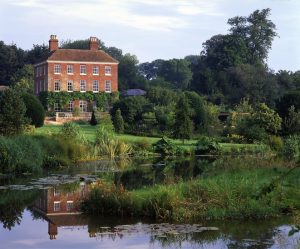 Photo credit: Georgina Viney Photography
Photo credit: Georgina Viney Photography
Dealing with the client
Randle told me that he always wanted clients to contribute as much as possible to put into the melting pot of ideas. At this point, I explored with him some of the ways in which he built up a reputation with clients and whether he had developed a particular approach. In particular, I asked to what extent each project was driven by the client. He replied, ‘I’m always there holding the client’s hand and then sometimes I say, ‘actually, I don’t agree with you’, or at other times I say, ‘yes, that’s a really good idea and we will go away and think about that.’ He wanted the client on the journey, right from the very beginning to the end. It was really important for the client to take ownership of their garden as a collection of ideas.
In Randle’s practice the end result is usually a traditional landscape design rather than a contemporary one. Nevertheless, Randle was at pains to say that he relishes the challenge of designing a contemporary garden, such as one he created in Geneva: the house literally resembled a white box and he created a contemporary garden around it to reflect its modernism.
One challenge that Randle occasionally encountered was a misunderstanding about design fees. Some prospective clients might not anticipate the costs associated with professional design services. When proposed fees are discussed, and there’s a significant difference in their expectations, it indicates a disconnect.
In these situations, Randle takes the opportunity to educate clients about the value of his expertise and the investment required for quality design work. If there’s still misalignment, he expresses his thanks for considering their services, understanding that clear communication about expectations is vital for a successful partnership.
Randle said that a similar issue can arise when giving a quote for maintenance. It can be easy to underestimate the amount of time needed for proper aftercare, which may involve a significant cost. ‘It’s like property management – you can’t service a building properly if you are going to cut corners from day one’ – something at Somerset Estates, that we swear by.
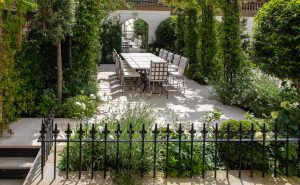 Photo credit: Georgina Viney Photography
Photo credit: Georgina Viney Photography
The changing world of the landscape architect
I was interested to learn about the difficulties Randle encountered when he started out, and how working practices had changed since that time. I was particularly keen to find out how Randle had taken on advances in technology.
The first stumbling block that Randle encountered in his career was to overcome the barrier of not having formal accreditation as a landscape architect. He did this by employing landscape architects, and then by developing the business known as ‘Randle Siddeley Associates, Landscape Architects’. He said: ‘I do think that breaking down barriers is very important in the world of design, and that is probably the biggest thing I’ve seen and I’ve changed. I think I’ve been quite a leader in the industry by saying, ’there’s got to be easier ways of doing this.’
Randle told me that much has changed over the years, and it was really important to be aware that you cannot stop evolution and the development of landscape design. He believed that we’re learning all the time and that never stops: it’s all part of the evolution of life. For example, it was only in the 1980s that the use of colour really took off in the world of printed magazines: the whole world suddenly became much more colourful.
He thought that the industry had really blossomed since he started out: now there are many more people involved, much more information available and many more materials to choose from. It is easier to see what other people are doing. He cited the Chelsea Flower Show as still being a great barometer of design, where you could find out the direction that everything is going in, the latest ideas and the endless possibilities.
And, yes, Randle had fully embraced new technology. He thought the changes brought about by AI (artificial intelligence) and CGIs (computer generated images) were monumental. Although Randle still preferred doing drawings in a more freehand way, other people now wanted to see CGIs being used, so they could see a design as close to reality as it could possibly be. And he used drones – before, during and after construction, which was a really good way of giving the client an impression of the ‘before and after’, all in a few minutes, in true 21st century style.
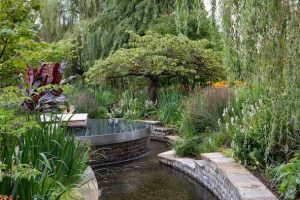 Photo credit: Georgina Viney Photography
Photo credit: Georgina Viney Photography

